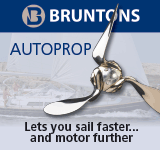Forum Replies Created
-
AuthorPosts
-
December 3, 2021 at 1:37 am in reply to: Please help identify this sailboat Make Model Designer #85301
 PaulKParticipant
PaulKParticipantSince there were no NY state registration numbers, I looked up Dolores on the USCG Documentation registry. Lots of boats in Dolores CO, owners on Dolores Avenue, owners named Dolores, and boats named Dolores, but none in New Rochelle.
Your photo from aft makes it look like the companionway may be slightly off-center, which is another good clue. It is not likely for an owner to change the rudder from its original shape. The best clue for a builder is likely going to be the covestripe, with the dot and arrow at the bow and dot and feathers at the stern. This link: https://web.archive.org/web/20050206195446/http://www.goodoldboat.com/cove_stripes.html
makes it look like she might be a Bristol, but the arrow at the bow isn’t the right shape. Irwin is also close, but the ports don’t match any Bristol or Irwin designs shown on the sailboatdata website. She may be imported, but I dld not find any LeComte, VandeStadt, or DeVries-Lentsch designs that matched either.December 2, 2021 at 4:08 am in reply to: Please help identify this sailboat Make Model Designer #85294 PaulKParticipant
PaulKParticipantCape Dory portlights don’t match, so not one of theirs. Morgan 34 looked promising, but the rudder isn’t right. Too much wood for a Pearson, even one that old. The main hatch arrangement is a bit unusual, and the wood ‘eyebrow’ on the cabin trunk sets it apart. US Yachts ? With the cutaway keel and attached rudder has to be a 60’s design.
 PaulKParticipant
PaulKParticipantThe winged-keel on a Pearson I sailed on seemed to dampen the movement of the boat a good bit – stabilizing it, and making it feel much larger than the 28-some feet it was.
 PaulKParticipant
PaulKParticipantHave you not looked here?
https://sailboatdata.com/sailboat/alacrity-19
or on Google?
What sort of modifications or re-fit ideas are you contemplating? You might be able to attach wheels to the twin keels so that it could be ramp-launched without need for a trailer. PaulKParticipant
PaulKParticipantPictures of the profile, stern, and cockpit/cabin area might help. The blue bulwark(?) with pierced aluminum top/toerail does not appear like a standard ‘production’ boat feature. Mast-mounted winches might indicate a ’70’s build.
 PaulKParticipant
PaulKParticipantPHRF ratings vary by region because they are set up to reflect how different boats perform in the different regions. Long Island Sound generally has relatively light wind (10-12 knots) with small waves (up to .75m). Narragansett Bay and Northern California tend to have stronger breezes – 15-20 knots, with heftier waves 1- 1.5m. The ratings for the X442 show that they do not seem to be super fast in light air, but perform better when the breeze picks up and their size enables them to cut through the waves. To compare your boat with others using PHRF ratings you should first find a PHRF region with characteristics similar to those where you sail. Then look up the ratings for the different boats in that region. This will obviously work better for widely spread production models like Beneteaux, which will have people racing them in PHRF fleets in the US as well as in Australia. PHRF Committees don’t issue ratings for boats that aren’t racing in their area, so you probably won’t find US PHRF ratings for Stevens 34’s, for example, because there aren’t many sailed here. I spoke with X-Yacht’s Nils Jeppsen once at the Paris Boat Show and was impressed with how well his boats were put together. Their performance has also been impressive.
 PaulKParticipant
PaulKParticipantFor the YRALIS the base rating for the X-442 is 42 across the board, for spinnaker, non spinnaker, buoy and long-distance. Various things like propeller type and genoa, spinnaker or sprit size may lead to adjustments from the base.
 PaulKParticipant
PaulKParticipantLooks like a nice design by S&S. South Hants Engineering built them, hence the “SHE”. Blowing up an image of the plans shown here on Sailboatdata might give an indication of the original engine installed, or its horsepower. Barring that you might want to measure the engine mounts and available space and then talk to a mechanic. A quarter-tonner is not going to need a super-powered engine, and there may be many suitable. They will not be cheap.
Repairing the shroud anchor points will depend on what the problem with them is. A photo would help better define what’s wrong. On a boat of this period the shrouds likely attach to the main bulkhead. If it is rotted or delaminated it will need to be fixed – a major repair. If the shrouds attach to flanges that are fiberglassed to the hull, the fix may be somewhat less complicated. Good luck! PaulKParticipant
PaulKParticipantThe best way to learn about rigging these boats may be to look up photos of them. It may take weeding through a bunch, but they are bound to show what you need to know. You should be able to make sure the photo matches your boat, and then just set things up the way they look in the picture. The picture on the site here at Sailboatdata would be a start. These guys: OfficialAMFPufferGroup@groups.io might also be helpful.
 PaulKParticipant
PaulKParticipantI would start by looking here:
July 30, 2021 at 3:11 am in reply to: Mounting Bulkhead Compass on Forward Bulkhead of 1984 MacGregor25, Bulkhead Angles #84982 PaulKParticipant
PaulKParticipantIt sounds like you need to use a plumb-bob or level to find “straight up” at the port-side bulkhead. Then you need to make a shim that matches the angle that forms with the bulkhead, and use it when mounting the compass on the bulkhead. There is no set “angle” that anyone can give you, because each boat will float a little differently. Some may have more chain in the anchor locker, or stow diving gear aft. This is a custom installation.
 PaulKParticipant
PaulKParticipantWhile it may be nice to have the class insignia on the sail, it is not a requirement. We had four mainsails for our J/36. Only one of them had the J/36 logo/insignia. Perhaps it would be a good task for the sailmaker, since he’s the one who will need to cut it out and apply it to the sail.
 PaulKParticipant
PaulKParticipantSome boats have to have the rudder removed before the propeller shaft can come out. This is one of the reasons that Sabre built many of their designs with offset shafts. Their rudders don’t have to come out. It may be possible to install the new seal on your boat without taking the shaft out all the way, but going over the whole thing with your mechanic to explore all the options would probably be a good idea.
 PaulKParticipant
PaulKParticipantYour best bet is to talk to a sailmaker. He will have to come and look at the boat and measure things. Mizzen staysails can vary a good bit, depending upon the owner’s desires and the boat’s design, so the cut and size are not set in stone, even if the Naval Architect drew a sailplan that included one. Where the sail is tacked to the deck can also change how it works. Mizzen staysails, done right, can add a half knot to boat speed. Getting them cut and set so as to do that is not necessarily easy.
July 11, 2021 at 4:48 pm in reply to: Need a Help MAXI 77 design category and sailing category #84923 PaulKParticipant
PaulKParticipantYour best bet would be to contact Maxi Yachts in Sweden:https://www.facebook.com/MaxiYachtsShipyard/
They even have a form there for asking them questions.
-
AuthorPosts

